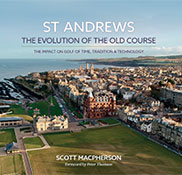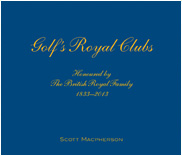GOLF CHAMPIONSHIPS ON SMGD COURSES:
At Close House – Colt Course. Sept 2017. A prestigious European Tour Championship hosted by Lee Westwood.
Broadcast worldwide from Royal Wellington Golf Club, NZ. October 2017. WOW!
The legacy continues.
Co-hosted at the award-winning Millbrook Resort near Queenstown, NZ. 2014 – 2023.
Designing ‘Fairness’
Scotland’s John L. Low was the first person to write about the principles of golf course architecture in his 1903 book, Concerning Golf. In summarising his philosophy he said ‘A course should never pretend to be, not is it intended to be, an infallible tribunal of skill alone. The element of chance is the very essence of the game, part of the fun of the game.’ H.N Wethered concurred in 1931 and wrote ‘In the old spirit of the golf, ‘luck’ was regarded as part of the legitimate fun of the game, without which as a sport the game would suffer.’ Designing adventure is the role of the golf course architect, only the rules determine ‘fairness’.
Balance and variety within design are goals of the astute architect. In 1992 American architect Tom Doak wrote ‘The course with the widest variety of holes has everything. It will be a fair course because it is not designed around one particular shot pattern, and lets all players demonstrate their golfing skills’. Indeed Muirfield, host of numerous Open Championships include the 2013 Open is considered by many including Jack Nicklaus as one of the most balanced golf courses because if fails to favour any particular shot type.
Hazard visibility, placement, type and severity often incite accusations of unfairness but John L. Low (1903) said ‘No hazard is unfair wherever it is placed’. Robert Hunter added in 1926, ‘Some of the most interesting hazards punish severely extremely well-played shots….yet even he who pays the penalty knows that were it not for these magnificent hazards- so often placed haphazard- golf would not possess that overpowering fascination which makes the game sublime.’ ‘It is absurd to penalise one player’s distance off the tee more than the other.’ Doak concluded, ‘The fair solution to the positioning of fairway bunkers is to avoid any repetition of distances.’
In the early 1900’s American courses were being designed with flat fairways in another attempt to ‘design fairness’. However popular English architect Harry Colt, famed for courses such as Sunningdale, Wentworth and Pine Valley (with G. Crump) wrote in 1912 ‘Undulations are of great value….as they provide difficult stances and lies, without which no golf course can be said to be quite perfect…’ Dr MacKenzie having witnessed Colt working on his home course of Alwoodley in England (before his own entry to golf architecture) later agreed and advanced the point by writing in 1920 ‘A common delusion is that fairways should be flat. There are few things more monotonous than playing every shot from a dead flat fairway. The unobservant player never seems to realise that one of the chief charms of the best links is the undulating fairways, where one hardly ever has a level stance or level lie. It is this that makes for variety, and variety is everything in golf.’ American Robert Hunter, after having worked as on-site assistant to MacKenzie at Cypress Point, where few fairways are ‘flat’, soon embraced this same British design theory and stated in his celebrated book The Links (1926) ‘Many of our (American) designers think it advisable to plough up all fairways and drag them down to dead level. This has been a custom so general in America that many good golfers complain when they have to play with a stance not on a level with their ball.’ before concluding, ‘Some young American champions drive superbly from flat lies and pitch like angels to soggy greens, but find themselves hard put where every shot in the bag has to be played.’
With the ‘Golden Age’ of golf course architecture still in progress, renown architects T. Simpson and H.N Wethered commented on designing fairness in 1929 stating ‘Every class of player has an individual method of defining ‘fairness’. What is ‘fair’ for the one is regarded as the grossest injustice by the other. The architect’s object is to encourage enthusiasm, mental agility and happiness in the hearts of all golfers whether they be magnificent, passably good or totally indifferent…’ In his book Golf Architecture (1920) MacKenzie wrote ‘At first sight the golfer looks upon it as grossly unfair that, of two shots within a few inches of each other, one should be hopelessly buried in a bunker and the other should be in ideal position. This however is the chief characteristic of all good holes. Holes of this description not only cater for great judgment, but great skill’… perhaps omitting to add, and a little luck. However notable Canadian architect and author of ‘Scotland’s Gift Golf, C.B Macdonald philosophically wrote in 1928 ‘Many people preach equity in golf. Does any human receive equity in life? He has to take the bitter with the sweet, and as he forges through all the intricacies and inequalities which life presents, he proves his mettle. Equity has nothing to do with golf. If founded on eternal justice the game would be deadly dull to watch or play. The essence of the game is inequality. Take your medicine where you find it and don’t cry….If there were not more or less luck in the game it would not be worthy.’
Golf is compared by many to life, but MacKenzie compared golf to the great British sport of Cricket. Referring to fortune and fairness he said, ‘You can no more eliminate luck in golf than you can in cricket, and in neither case is it possible to punish every bad shot. If you succeeded you would only make both games uninteresting. In both games it is only a proportion of bad shots that get punished, but not withstanding this, the man who is playing the best game almost invariably comes out on top.’ True, those playing higher percentage golf will ultimately win; a champion may have a bad hole, but over the course of four rounds will still win the championship.
Good links players disassociate often themselves from the shot once it has left their clubface. They know any tiny wind gust can force their ball to hit the wrong side of a hump and spoil the outcome of a well-hit shot. Equally, they know a good tee shot can come to rest in divot with just as much statistical probability as a poorly shot stuck can receive a good lie and vice versa. They know it is fateful to correlate the quality of which a shot is struck with the lie it receives. The only result is mental anguish. If golfers really wanted ‘fair’ results for ‘fair’ shots, golf would have to be played indoors and not outside on the unpredictable, undulating, wind ravaged Links where it began.
So while good architects are creating undulations, the rules try to officiate golf on a level playing field. Cleverly however, the ‘fair’ rules recognise the importance of fortune by deliberately and consciously being written in a manner that fails to conspiring against it. The misery of incidents such as seeing a shot of excellence strike a flag-stick and ricochet into a nearby water hazard are not legislated for. That’s unlucky not unfair. Had that same ball got caught in the flag and dropped in the hole, would it have been called fortune or fair? Fortune of course. In the rules, old divots are not considered GUR because there is a deliberate skill to extracting a ball from them. Equally, playing a shot from a road or path (considered an integral part of a course) requires certain shot making abilities. No rule allows players to hit another shot if their first shot hops awkwardly into a bunker. 1951 saw the abolition of the ‘stymie’ because it was considered ‘unfair’ that many important matches were being decided by the accident of the one ball lying in front of the other. So in order of priority the rules want you to, ‘Play the ball as it lies, play the course as you find it, and if you can’t do that, do what is fair’.
Modern calls for designing ‘fairness’ are neither new, nor wise, nor possible. Ideal holes should have are variety of play options with hazards littering the direct line to the flag so players negotiate their safe passage like ocean Captains plotting their course through icebergs in the Arctic seas. Players must take responsibly for their shots, be industrious and resilient, and ideally be inspired to improve their game by the placement and severity of certain troublesome hazards. As for officiating play, consult the ‘fair rules’. As H.N Wethered poignantly stated in 1931, ‘To be truly admirable, a course will probably incur in the general opinion the accusation of being unfair.’
AWARDS
 Winner
Winner
Excellence in Compliance Award
Royal Wellington Golf Club
PUBLICATIONS
 St Andrews
St Andrews
The Evolution of the Old Course
by Scott Macpherson
TESTIMONIALS
"During both the design and construction phases their can-do attitude to problem solving was refreshing".
Ben O'Malley, Millbrook Country Club, NZ



